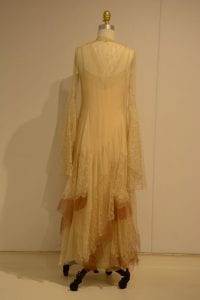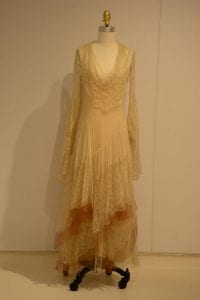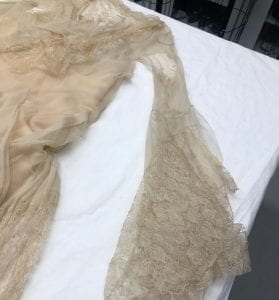Blog post by Maya Pierce ’25
This online blog post features materials protected by the Fair Use guidelines of Section 107 of the US Copyright Act. All rights reserved to the copyright owners.


What does a bride wear to a wedding that doubles as a death sentence? For 1930s socialite Gertrude Heim Klemm the answer was clear: you dress extravagantly and follow all the trends at the time to a tee. Gertrude Heim Klemm became Mrs. Gertrude Heim Remey when she married Charles Mason Remey on July 11, 1931, less than a year before allegedly shooting herself in the head twice. Her wedding dress is made completely out of silk, double trimmed with lace and brown silk (Figure 1). The silk textile is constructed with a leno weave, making the garment transparent (1301 – Wedding Dress, Silk Marquisette 2021). The socialite chose fashions typical of the time period: the long dress is cut on the bias with angular seaming, and the back is partially exposed through the use of a transparent lace panel on the back of the dress (Figure 2). The dress has a very low waist, and fits loosely on the body, despite being extremely small in size. The use of line is quite prominent in the gown, and placing the layers of fabric on the diagonal creates a sense of movement particularly when the dress is on the body in motion. The dress combines both a sense of geometric and organic form with straight lines that connect to flowy excess fabric that create a different shape with every move. Remey’s gown is translucent and stored with the slip she wore underneath. It seems to be a very revealing choice of clothing to be worn to one’s own wedding. Can the analysis of a wedding dress prove the amount of love in a relationship? The idea of the wedding dress is to wear something unique for a special day, so what does it imply that Klemm chose a dress just like any of the time but in white? While it could mean she was simply following and creating trends like the wealthy and beautiful do, it could also be a display of the lack of value and distinction she carried for that day.

The dress is currently in extremely fragile condition and the armpit areas are worn away and degraded perspiration. This area is the only part of the dress that shows this kind of wear, which would make sense typically because that is a place with rubbing and sweat (Figure 3). However, in the case of a wedding dress which is only to be worn once and for a few hours at that, it’s interesting that the wear is still so unevenly distributed. Silk is one of the strongest natural fibers, but over time it decays and becomes very fragile (Hooper 4). This is only worsened by the incorporation of tin in silks which makes the silks look shinier, but causes them to decay even faster, something known as silk shatter (Hooper 119). It’s hard to know if Remey’s silk dress was weighted with tin as it was not until 1953 that the Silk Association issued a demand to label all silk weighted with tin (New York Times). The dress does not appear shiny, nor does it have any extreme damage apart from the armpits, so it is possible that this silk was not weighted. However, silks were sold by weight and adding tin allowed sellers to mark up their fabrics. Remey, being the wealthy socialite she was, likely would have used the most expensive fabrics.
Charles Mason Remey donated his wife’s entire wardrobe to the Cornell Fashion + Textile Collection seven years after her death, and almost immediately after finding out about the collection. He likely would have rid himself of her clothes sooner had he known somewhere would take interest in them so soon. He tried to give away even more memories of her, such as a bust, but Professor Beulah Blackmore, the head of the collection at the time, responded that she and her colleagues were “puzzled” by this offer. Eventually Cornell did acquire this bust and it is still at the school. This points to the unavoidable question pertaining to her death: why was Charles Mason Remey so eager to rid himself of her possessions, and more importantly, how does someone commit suicide by two gunshot wounds to the head? It is possible to do, but unlikely and difficult. It is possible to maintain consciousness for a little while after the first shot (depending on where in the head the bullet goes of course) just enough to pull the trigger again, and deaths like this have occurred (Maghin et al, 2019). While it is possible that Gertrude Heim Remey did indeed commit suicide, it could have also been her husband who committed the act. Perhaps he truly wanted people to learn about fashion and being in possession of his wife’s clothing filled him with sadness in her memory. Maybe he wanted her money and a tax deduction. The mysteries of this couple will probably never be resolved, but Charles Mason Remey went out of his way to ensure his wife’s legacy was of her wardrobe rather than her death.
References
1301 – Wedding Dress, Silk Marquisette. (2021). Pastperfectonline.com. https://cornellfashion.pastperfectonline.com/webobject/7BE377C1-00C6-4AEF-9CDF-759072102530
Hooper, L. (n.d.). Silk, its production and manufacture – 6 [Review of Silk, its production and manufacture – 6]. Sir I. Pitman Sons, Ltd.,.
Maghin, F., Antonietti, A., Farina, D., Benedetti, P., & Verzeletti, A. (2019). A case of suicide by double gunshot wounds to the head: the ability to act after the first shot. International Journal of Legal Medicine, 133(5), 1469–1476. https://doi.org/10.1007/s00414-019-02085-2Links to an external site.
Perspective | This ill-fated tomb was party central for a generation of Northern Virginia teens. (n.d.). Washington Post. Retrieved December 6, 2021, from https://www.washingtonpost.com/local/this-ill-fated-tomb-was-party-central-for-a-generation-of-northern-virginia-teens/2019/02/12/5ac7023e-2ec5-11e9-86ab-5d02109aeb01_story.html
WARNING IS ISSUED ON WEIGHTED SILK; Association Reminds Trade of Labeling Rules Following Tin Release to Dyers. (1953, April 29). The New York Times. https://www.nytimes.com/1953/04/29/archives/warning-is-issued-on-weighted-silk-association-reminds-trade-of.html